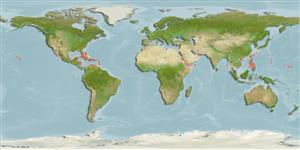Common names from other countries
Environment: milieu / climate zone / depth range / distribution range
Ekologi
; air tawar; kisaran kedalaman 0 - 1 m (Ref. 83435). Tropical; 32°N - 9°N, 90°E - 60°E (Ref. 83435)
Indo-Pacific and Western Central Atlantic.
Length at first maturity / Size / Weight / umur
Maturity: Lm ? range ? - ? cm Max length : 3.5 cm SHL jantan/; (Ref. 349); common length : 2.5 cm SHL jantan/; (Ref. 349)
Used as food by coastal populations of oceanic islands in the West Pacific (Ref. 349). Very common in the upper part of shores, often in crevices and pits of rock benches, or on branches of littoral trees overhanging the water. Moves up and down the shore in correlation with the prevailing high water level of the tide and can withstand heat and desiccation for long periods (Ref. 349). Nocturnal. Grazes on surface film of very fine marl particles, detritus, algae, flagellates, diatoms and nematodes (Ref. 96894).
Life cycle and mating behavior
Kematangan | Reproduksi, perkembang biakan | Pemijahan | telur-telur | Fecundity | Larva
Members of the order Neritopsina are mostly gonochoric and broadcast spawners. Life cycle: Embryos develop into planktonic trocophore larvae and later into juvenile veligers before becoming fully grown adults.
rujukan utama
Acuan | Koordinator | mitra
Poutiers, J.M. 1998. (Ref. 349)
Status IUCN Red List (Ref. 130435)
status CITES (Ref. 108899)
Not Evaluated
Not Evaluated
penggunaan manusia
Perikanan: komersial
| FishSource | Sea Around Us
Alat, peralatan
informasi lanjut
Umur / SaizPertumbuhanpanjang-beratpanjang-panjangMorfologiLarvaKelimpahan
Sumber internet
Estimates based on models
Preferred temperature
(Ref.
115969): 25.2 - 28.9, mean 27.7 (based on 945 cells).
keancaman
Low vulnerability (10 of 100).
kategori harga
Unknown.
